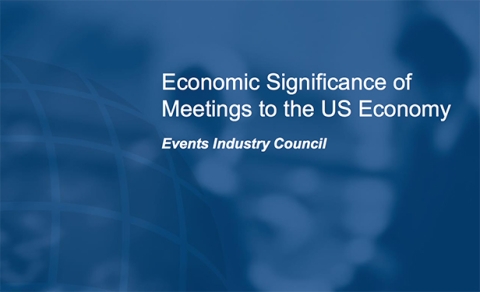Meetings and Events are Crucial to a Thriving U.S. Economy, New Study Finds

As the events industry continues to be tasked with making the case for the value of face-to-face meetings and events, a new report commissioned by the Events Industry Council (EIC) has been released that will not only help the industry drive that case home but also prove what it has long known to be true: the meetings and events sector is critical to a healthy and thriving national economy.
According to the Economic Significance of Meetings to the US Economy, conducted by independent global advisory firm, Oxford Economics, and supported by the Meetings Mean Business Coalition and other industry partners, face-to-face meetings and events play an integral role in bolstering the U.S. economy and key business sectors.
The new report is an update of a 2009 study of the same name.
“Our report illustrates that the meetings and events industry continues to grow across all segments as it contributes hundreds of billions of dollars in revenue to the U.S. economy and supports 5.9 million jobs,” explained Adam Sacks, founder and president of Tourism Economics, an Oxford Economics company, during a Feb. 21 press briefing.
He continued, “Notably in 2016, meetings generated $325 billion of direct spending and $845 billion in business sales. These numbers represent a contribution of $446 billion in GDP and $104 billion of federal, state and local taxes. The total tax impact per household was $879 per U.S. household.”
Data for the report was compiled through a nationwide survey of meeting planners, exhibitors and venues and represents almost 9,000 domestic business travelers, almost 50,000 international air travelers and 11,000 hotels, resulting in research that represents the most comprehensive analysis of meetings sector impacts to date, according to EIC officials.
Key findings from the report include:
- In total, 1.9 million meetings were held in 2016, with 251 million participants. On average, the direct spending associated with 43 meeting participants supported one U.S. job, including both direct and indirect impacts.
- Meetings supported more direct jobs than many large manufacturing sectors, including machinery, food, auto and chemicals, and sustained more jobs than the telecommunications and oil and gas extraction industries.
- The cumulative economic impact of face-to-face meetings and events is hard to deny, with results showing that every dollar spent on face-to-face meetings and events generates an additional $1.60 – or 160 percent – in benefits for the U.S. economy.
- Direct spending on meetings expanded 23 percent between 2009 and 2016, primarily due to increases in the number of meeting participants.
- Business services was the industry most impacted by meetings in 2016, with $196.3 billion in total economic output. The finance, insurance and real estate industry followed with $141.1 billion in total economic output, followed by the manufacturing industry with $92.6 billion in total output.
Other industries that were positively impacted by face-to-face meetings and events include:
- Food and Beverage: Meeting organizers and hosts spent $48 billion to provide food and beverage services at meetings.
- Hotels and Lodging: Meetings generated 300 million room nights annually, representing nearly $50 billion of spending on accommodations.
- Travel and Tourism: Meetings-related travel expenses represented 13.2 percent of total travel and tourism spending in the U.S.
“This new research confirms that our industry plays a critical role in connecting people and bolstering crucial segments of our national economy,” said Paul Van Deventer, president and CEO of Meeting Professionals International (MPI) and co-chair of the MMBC, which is an industry-wide coalition created in 2009 that works to showcase the value that business meetings and events bring to people, businesses and communities.
He added, “The numbers reiterate what anecdotally we always knew to be true – no matter the industry, investing in face-to-face meetings is a smart choice.”
Of the 251 attendees that participated in the 1.9 million meetings and events held in the U.S. in 2016, six million were international attendees who generated $38 billion in meetings direct spending alone.
“While those international participants only generate about two percent of attendance, they represent 11 percent of spending because they tend stay longer and spend a great deal more when they visit the U.S.,” Sackler explained.
These findings underscore the importance of the industry working with the U.S. government to make it easier for international attendees to participate in U.S. meetings and events, he added.
“We’ve seen in the past that Visa policy has not always been conducive to international meeting participants being able to come and join in U.S. meetings, and that’s realized significant cost to the U.S. economy over time,” Sackler said.
He continued, “This research helps to create that foundation to advocate for the importance of those international visitors in particular and to ensure that Visa policies are set up in such a way that international meeting attendees can come without being hindered.”
According to Susan Robertson, executive vice president of the American Society of Association Executives (ASAE) and chair of the EIC, there has been a critical need for information quantifying the significance of face-to-face meetings and business events to the U.S. economy, and the data from the new report will also help support ASAE’s efforts to advocate overall for the importance of face-to-face meetings.
“In the association sector, so much science and education, technology and medicine and health care are advanced by face-to-face meetings, so proving their worth is a part of that advocacy picture that we’re very actively promoting at all times.” Robertson said.
She added, “Hosting an event, convention or trade show brings new revenue to industries across the country. So many people and companies beyond the scope of the events industry itself benefit from its reach.”
To read the full report, please click HERE.


Add new comment